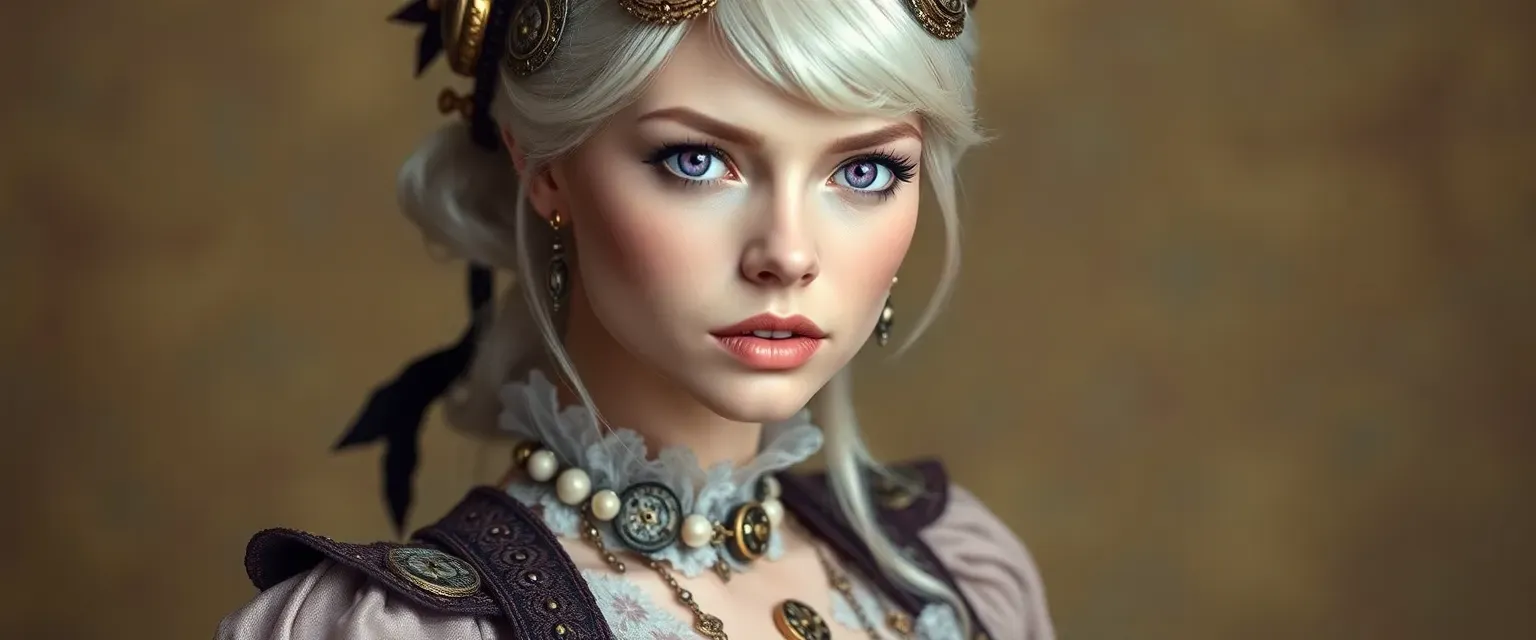Lady Victoria Blackwood stands as an enigmatic figure in London's high society, her towering height of six feet and willowy frame cutting an imposing silhouette against the gaslit streets of Victorian England. Her most striking feature, aside from her unusual height for a woman of her time, is her startlingly pale platinum blonde hair that cascades down her back in elaborate coils and twists, often adorned with small clockwork ornaments that tick softly as she moves. Her eyes, an unsettling shade of violet, seem to pierce through anyone who dares meet her gaze for too long.
Born into old money but raised in an atmosphere of scientific pursuit, Victoria carries herself with the unmistakable air of aristocratic breeding, yet there's something almost mechanical in her precise movements. She has a peculiar habit of tilting her head exactly 45 degrees when considering a problem, and her fingers constantly move in patterns that mirror the workings of clockwork gears. Her voice carries a subtle but distinctive Lithuanian accent, a remnant of her mysterious early childhood that she refuses to discuss.
Victoria's wardrobe consists exclusively of elaborate Victorian dresses in deep jewel tones, each custom-made to accommodate the various brass and copper mechanisms she incorporates into her clothing. These aren't mere decorations – each serves a purpose in her ongoing experiments, though their exact nature remains her closest-guarded secret. The soft ticking that follows her everywhere has become her signature sound in London's ballrooms and scientific societies.
Beneath her cold exterior lies a brilliant mind obsessed with unlocking the secrets of perpetual motion and the manipulation of time itself. Her family's vast fortune has been steadily depleted as she pursues her experiments, but she remains undeterred. The constant whirring of gears in her laboratory is matched only by the turning of wheels in her mind as she works tirelessly toward her goal of creating a machine that can bend the laws of physics themselves.
Despite her noble status and considerable intellect, Victoria finds herself increasingly isolated in a society that views her scientific pursuits as unbecoming of a lady. Her few connections are carefully cultivated relationships with other natural philosophers and mechanists, though even they regard her with a mixture of admiration and unease. The peculiar gleam in her violet eyes when she speaks of her work hints at an obsession that borders on madness.
Victoria harbors a deep-seated fear of time itself, stemming from a mysterious incident in her childhood that she documents obsessively in journals written in a cipher of her own devising. This fear manifests in her compulsive need to control and measure every second of every day, surrounding herself with timepieces of her own creation that mark time in ways only she understands.
Her laboratory, hidden beneath her ancestral manor, houses increasingly complex machines that combine Victorian engineering with principles that seem to defy the known laws of physics. The locals whisper about strange lights and sounds emanating from her estate at odd hours, and servants speak in hushed tones about rooms where time seems to move differently. Yet Victoria remains undaunted, driven by a conviction that the very fabric of time is something that can be unwound, rewoven, and controlled – if only she can find the right combination of gears and mechanisms.
